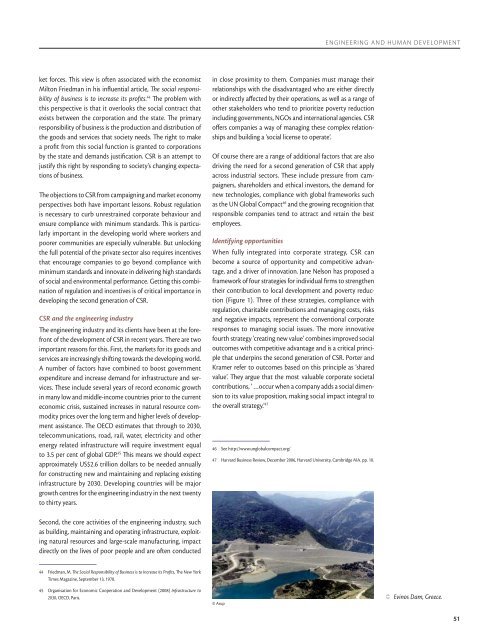Engineering: issues, challenges and opportunities for development ...
Engineering: issues, challenges and opportunities for development ...
Engineering: issues, challenges and opportunities for development ...
You also want an ePaper? Increase the reach of your titles
YUMPU automatically turns print PDFs into web optimized ePapers that Google loves.
ENGINEERING AND HUMAN DEVELOPMENTket <strong>for</strong>ces. This view is often associated with the economistMilton Friedman in his influential article, The social responsibilityof business is to increase its profits. 44 The problem withthis perspective is that it overlooks the social contract thatexists between the corporation <strong>and</strong> the state. The primaryresponsibility of business is the production <strong>and</strong> distribution ofthe goods <strong>and</strong> services that society needs. The right to makea profit from this social function is granted to corporationsby the state <strong>and</strong> dem<strong>and</strong>s justification. CSR is an attempt tojustify this right by responding to society’s changing expectationsof business.The objections to CSR from campaigning <strong>and</strong> market economyperspectives both have important lessons. Robust regulationis necessary to curb unrestrained corporate behaviour <strong>and</strong>ensure compliance with minimum st<strong>and</strong>ards. This is particularlyimportant in the developing world where workers <strong>and</strong>poorer communities are especially vulnerable. But unlockingthe full potential of the private sector also requires incentivesthat encourage companies to go beyond compliance withminimum st<strong>and</strong>ards <strong>and</strong> innovate in delivering high st<strong>and</strong>ardsof social <strong>and</strong> environmental per<strong>for</strong>mance. Getting this combinationof regulation <strong>and</strong> incentives is of critical importance indeveloping the second generation of CSR.CSR <strong>and</strong> the engineering industryThe engineering industry <strong>and</strong> its clients have been at the <strong>for</strong>efrontof the <strong>development</strong> of CSR in recent years. There are twoimportant reasons <strong>for</strong> this. First, the markets <strong>for</strong> its goods <strong>and</strong>services are increasingly shifting towards the developing world.A number of factors have combined to boost governmentexpenditure <strong>and</strong> increase dem<strong>and</strong> <strong>for</strong> infrastructure <strong>and</strong> services.These include several years of record economic growthin many low <strong>and</strong> middle-income countries prior to the currenteconomic crisis, sustained increases in natural resource commodityprices over the long term <strong>and</strong> higher levels of <strong>development</strong>assistance. The OECD estimates that through to 2030,telecommunications, road, rail, water, electricity <strong>and</strong> otherenergy related infrastructure will require investment equalto 3.5 per cent of global GDP. 45 This means we should expectapproximately US$2.6 trillion dollars to be needed annually<strong>for</strong> constructing new <strong>and</strong> maintaining <strong>and</strong> replacing existinginfrastructure by 2030. Developing countries will be majorgrowth centres <strong>for</strong> the engineering industry in the next twentyto thirty years.in close proximity to them. Companies must manage theirrelationships with the disadvantaged who are either directlyor indirectly affected by their operations, as well as a range ofother stakeholders who tend to prioritize poverty reductionincluding governments, NGOs <strong>and</strong> international agencies. CSRoffers companies a way of managing these complex relationships<strong>and</strong> building a ‘social license to operate’.Of course there are a range of additional factors that are alsodriving the need <strong>for</strong> a second generation of CSR that applyacross industrial sectors. These include pressure from campaigners,shareholders <strong>and</strong> ethical investors, the dem<strong>and</strong> <strong>for</strong>new technologies, compliance with global frameworks suchas the UN Global Compact 46 <strong>and</strong> the growing recognition thatresponsible companies tend to attract <strong>and</strong> retain the bestemployees.Identifying <strong>opportunities</strong>When fully integrated into corporate strategy, CSR canbecome a source of opportunity <strong>and</strong> competitive advantage,<strong>and</strong> a driver of innovation. Jane Nelson has proposed aframework of four strategies <strong>for</strong> individual firms to strengthentheir contribution to local <strong>development</strong> <strong>and</strong> poverty reduction(Figure 1). Three of these strategies, compliance withregulation, charitable contributions <strong>and</strong> managing costs, risks<strong>and</strong> negative impacts, represent the conventional corporateresponses to managing social <strong>issues</strong>. The more innovativefourth strategy ‘creating new value’ combines improved socialoutcomes with competitive advantage <strong>and</strong> is a critical principlethat underpins the second generation of CSR. Porter <strong>and</strong>Kramer refer to outcomes based on this principle as ‘sharedvalue’. They argue that the most valuable corporate societalcontributions, ‘ …occur when a company adds a social dimensionto its value proposition, making social impact integral tothe overall strategy.’ 4746 See http://www.unglobalcompact.org/47 Harvard Business Review, December 2006, Harvard University, Cambridge MA. pp. 10.Second, the core activities of the engineering industry, suchas building, maintaining <strong>and</strong> operating infrastructure, exploitingnatural resources <strong>and</strong> large-scale manufacturing, impactdirectly on the lives of poor people <strong>and</strong> are often conducted44 Friedman, M. The Social Responsibility of Business is to Increase its Profits, The New YorkTimes Magazine, September 13, 1970.45 Organisation <strong>for</strong> Economic Cooperation <strong>and</strong> Development (2008) Infrastructure to2030, OECD, Paris.© Arup Evinos Dam, Greece.51

















